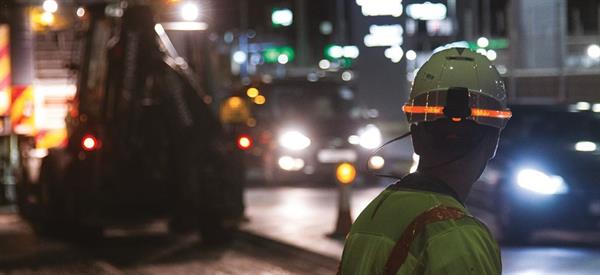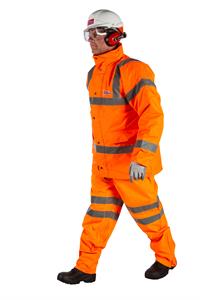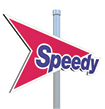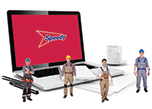
What is Traffic Management?
Traffic management involves supporting workers on the road by providing safety equipment such as cones and barrier fences, as well as putting up traffic lights and diverting traffic through a series of road closures and diversions.
When you approach a section of road works in your car, you’ll often see vans with cones and other equipment in the back, and it is these teams of traffic management operatives who have put the protective zone in place to look after those who carry out the works.
The temporary fencing that protects workers and any road-closed signs is put in place by a team booked to support specialist teams, implementing any closures and diversions for a limited period before taking the cones and any temporary fencing away at the completion of the project.
Traffic management, also known as road traffic control, is most common during roadworks, but can also be required in emergencies such as traffic collisions, road resurfacing, and traffic congestion, or for planned events such as construction works, events, and maintenance works.
It can be important in communities as it can allow proper traffic flow, reducing congestion and minimising air pollution and disruption.
Why is Traffic Management Important?
Traffic management is necessary for the safety of both road workers and those using the roads.
Without traffic management operatives, the roads would be hazardous places for teams tasked with carrying out repairs to the road surface or any drainage, or attending to an emergency. The teams who put up the temporary traffic lights or who stand with manual stop-go boards are trained to control traffic in such a way that the risk to workers is minimised and that any drivers forced to take a diversion can do so in a way that causes minimal disruption.
Of course, there are times when traffic management teams are called out in emergencies, such as burst water mains on a road or when the police require their help after an accident. Traffic management teams can be on the scene to provide support diverting traffic away from the area while the authorities and specialist teams get to work on making repairs without the dangers of fast-moving, free-flowing traffic all around them.
Proper traffic management decreases further risks to road users and ensures repairs and attention can be carried out as quickly as possible.
Who are traffic management operatives?
A traffic management operative must be trained in order to control traffic. Any company that works on the road network needs the relevant NHSS (National Highways Sector Schemes) certification. That includes traffic management firms, road maintenance companies, fencers, and landscapers.
Individuals may be trained with an NHSS certification, or the whole team may be certified, but only those who are certified can control the traffic.
What types of Traffic Management are there?
Traffic management may include:
- Lane closures on motorways or dual carriageways
- Diversions which close a road
- Diversions which reduce a road to one lane and "Stop and Go" boards are used
- "Give and Take" traffic management which tapers traffic, but drivers pass at their own discretion
- Forming barriers around an obstacle but maintaining safe traffic flow
It completely depends on what the hazard is, what the road layout is like, how much traffic is using the road at the time, and how practical it is to close the road.
Traffic management operatives are assigned with choosing the correct management approach, and correctly enforcing it to minimise disruption yet offer maximum safety to workers, construction sites, and drivers/pedestrians.
How to keep traffic management operatives safe in winter
Being on the front line puts traffic management operatives at increased risk of injury during the winter months, often being out of the van and putting up cones in the dead of night while the roads are quiet – but not entirely empty. During these periods, and – of course – during the daytime and rush hours in particular, there are a number of ways in which traffic management operatives can be kept safe:
- Hi-vis clothing. This one is a given and a form of PPE, but one that should never be overlooked. Hi-vis jackets and trousers will help operatives to stand out to oncoming headlights when closing lanes or roads, or implementing diversions.
- Safety helmets with lights. Another important piece of safety equipment, with a handy addition. A safety light on the top of your helmet will not only illuminate the immediate surroundings but make operatives more visible to other road users, too.
- 2024
- 2023
- December 2023 (13)
- November 2023 (10)
- October 2023 (6)
- September 2023 (10)
- August 2023 (20)
- July 2023 (21)
- June 2023 (17)
- May 2023 (17)
- April 2023 (17)
- March 2023 (14)
- February 2023 (15)
- January 2023 (7)
- 2022
- December 2022 (6)
- November 2022 (12)
- October 2022 (24)
- September 2022 (14)
- August 2022 (12)
- July 2022 (15)
- June 2022 (18)
- May 2022 (14)
- April 2022 (9)
- March 2022 (5)
- February 2022 (5)
- January 2022 (2)
- 2021
- December 2021 (7)
- November 2021 (10)
- October 2021 (1)
- September 2021 (1)
- August 2021 (3)
- July 2021 (3)
- June 2021 (4)
- May 2021 (1)
- April 2021 (1)
- March 2021 (2)
- February 2021 (1)
- January 2021 (1)
- 2020
- 2019
- 2017
- 2016
- 2014
- 2013
- 2012
- 2011


